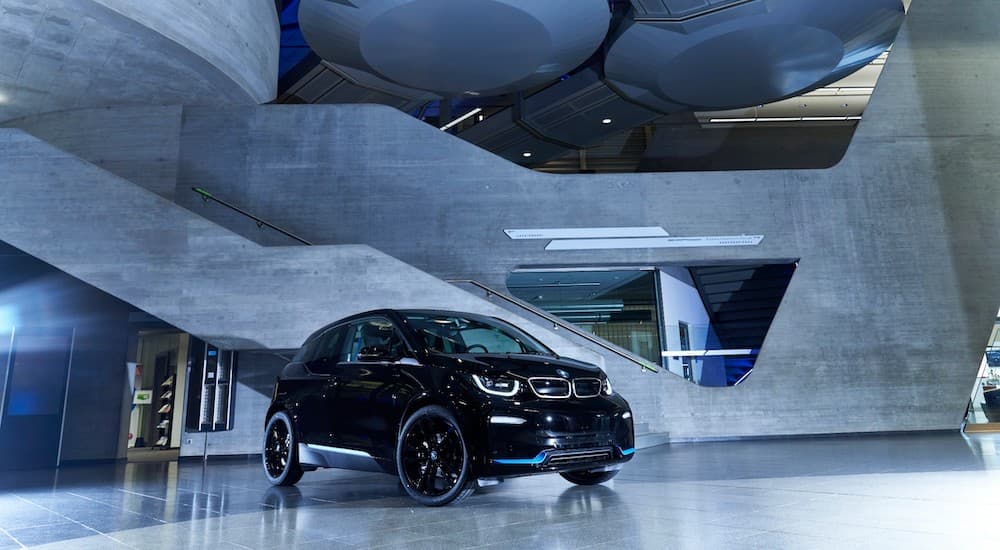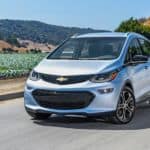If you have been shopping for an EV, then you have probably heard the term “one-pedal driving” mentioned a time or two. However, if you haven’t yet taken an electric car for a test drive, you might be skeptical of what this means and why anyone would want it. Even if you do have a basic understanding of what one-pedal driving brings to the table, you might not yet be aware of some of the differences between how manufacturers have implemented the technology. Wherever you are on the EV awareness spectrum, get ready to learn the whole story behind this exciting new technology.
What Is One-Pedal Driving?
As it sounds, one-pedal driving is the ability to accelerate and decelerate your vehicle using a single pedal. Press the pedal down to go faster and lift off to slow down. “But any car will slow down when you lift off the gas,” you might be saying. Well, that’s true – but thanks to regenerative braking, when you lift off the accelerator pedal in an electric car, it can feel like you’re pressing the brakes. While current EVs still have traditional brakes and a traditional brake pedal, you will find that you really don’t need to use them much because of the power of regenerative braking.
Regenerative braking was first introduced to the world with the Toyota Prius, and if you’ve ever driven a hybrid, you may have noticed that you slow down a lot quicker than in a traditional gas car when you let off the accelerator. That is because the electric motors double as generators, converting rotational energy from the wheels into electrical energy stored in the battery. In a hybrid, the effect is noticeable, but it isn’t really strong enough to qualify as one-pedal driving – you still have to use the real brakes if you want to come to a stop in a timely manner.
In all-electric cars, you will find the same basic principle, except it is paired with much more powerful electric motors. The additional force of these motors can allow the car to even come to a complete stop relatively quickly without touching the brakes. While you won’t want to rely on one-pedal driving in an emergency situation, with a little practice, you can handle most driving situations without ever putting your foot on the brake pedal.

The History of One-Pedal Driving
While regenerative braking arrived with the Toyota Prius, one-pedal driving was introduced to the world with the 2008 Tesla Roadster. Although the term itself didn’t enter common use until a while later, even early reviews of the first Tesla noted with amazement how the car would bring itself to a stop without any need for the brakes. They also tended to note that the transition between acceleration and regenerative braking was somewhat jarring in the Roadster, but that has been engineered out of more modern models. In fact, electric cars are now known for their incredibly smooth ride since there are no gear shifts or sudden braking to jerk passengers around.
Since regenerative braking is entirely computer-controlled, as more EV models were introduced, manufacturers began putting their own mark on how one-pedal driving worked in their products. They also began offering selectable modes, so the driver could tweak the level of regenerative braking to match their driving style. Tesla was the first to offer this with the 2012 Model S. Because EVs were still brand-new at the time, Tesla gave drivers the option to choose between full regenerative braking or a setting that made the Model S behave just like a gasoline car, including creeping forward when your foot was off the brake.
However, the modern idea of one-pedal driving was introduced with the 2019 Nissan and its “e-Pedal.” This somewhat primitive system combined regenerative braking with the mechanical brakes, allowing the car to be brought to a complete stop and held in place simply by lifting off the accelerator. Tesla was right behind them, making One-Pedal Driving an official feature on all of its models in 2019. While the principle was unchanged from the early Tesla Roadster, the official feature gave drivers access to different levels of regenerative braking and integrated it with Tesla Autopilot.
Since Tesla and Nissan are the most established EV manufacturers, it is not surprising that they and their customers have fully embraced the idea of one-pedal driving. Some of the newer brands to the scene don’t feel the same way and have chosen to offer different forms of regenerative braking in their vehicles. The Chevy Bolt EV, for instance, offers extremely mild regenerative braking when you lift off the accelerator. However, you can pull a paddle on the steering column to engage heavy regenerative braking to slow the vehicle faster – but you still need to press the brakes to come to a full stop.
New luxury EV models from BMW and Mercedes go even further, giving you multiple selectable levels of regenerative braking from nearly nothing all the way up to full one-pedal driving (although Mercedes still requires you to use the mechanical brakes to come to a full stop). They even offer “adaptive” models where the vehicle senses how much regeneration you want depending on the environment and your inputs. This may help cover the transition from traditional gasoline models to electric cars, but it remains to be seen if they will follow the lead of Tesla and Nissan in committing fully to one-pedal driving as the default.

The Benefits of One-Pedal Driving
We expect that there will be more emphasis on one-pedal driving as EV technology becomes more mainstream. While it can take some getting used to figuring out how to best use regenerative braking and knowing when you will need the traditional brakes, the benefits of one-pedal driving are considerable. The largest benefit is, of course, that the use of regenerative braking extends the vehicle’s range, recapturing energy that would have otherwise been lost. However, that is far from the most noticeable benefit to the owner of an EV with one-pedal driving.
The smoothness that comes from never having to switch pedals, and having a computer responsible for deceleration rather than a human foot, is part of what makes riding in an EV such a different experience (along with the complete absence of the noise and vibration from a gasoline engine). One-pedal driving can also help make driving a bit more engaging, much like the use of engine braking when driving a manual transmission. Combined with the efficiency gauges in most electric cars, it turns driving into something of a game to see just how far you can stretch the range of your car.
EV owners who use one-pedal driving are also generally surprised by just how little they need to replace the brakes on their cars. Because the electric motors handle nearly all the acceleration, the pads and rotors of the traditional brakes barely see any use. In fact, the new Gen3 car for the Formula E electric racing series has no rear brakes at all, relying entirely on regenerative braking instead. It may take a while for government safety regulations to allow such a design on public roads, but it would allow EV manufacturers who embrace one-pedal driving to further simplify their vehicles, giving customers less-expensive options and even lower maintenance costs.
One-Pedal Driving Is a New Standard
The idea of one-pedal driving is quickly spreading throughout the auto industry and is being embraced by consumers as well as manufacturers. In fact, not only are brands including it in their EV models, they are even beginning to put it in their gasoline vehicles! Ford has added a “Trail One Pedal Drive” mode to many of its off-road models, from the Ford Bronco to the Ford Raptor. While the powerful EcoBoost turbocharged V6 engines that power these vehicles don’t have any efficiency gain from the feature (it actually applies the mechanical brakes rather than using some sort of regenerative braking), it gives drivers more control when negotiating treacherous terrain since they no longer have to quickly switch between two different pedals.
Although one-pedal driving probably won’t become a common feature on all gasoline vehicles in the coming years, this is certainly an example of EV development advancing the auto industry as a whole. On the EV side of things, one-pedal driving is certainly here to stay, and few drivers who try it feel that it is a bad addition to their time behind the wheel. As EV technology continues to improve, we expect to see even more capable and intuitive versions of one-pedal driving appear on the market.



